Macroeconomics Homework Assignment: Okun's Law, Expenditure, Trade
VerifiedAdded on 2021/06/14
|13
|628
|27
Homework Assignment
AI Summary
This macroeconomics assignment solution addresses several key macroeconomic concepts. Answer 1 applies Okun's Law to calculate unemployment gaps and their impact on real GDP. Answer 2 analyzes planned aggregate expenditure, determines short-run equilibrium output, and calculates the real interest rate needed to achieve potential output. Answer 3 explores the car market, examining equilibrium, the effects of opening to international trade, and the impact of a tariff on consumer and producer welfare. The assignment includes calculations, analysis, and graphical representations, demonstrating a strong understanding of macroeconomic principles. The solution also provides a bibliography of relevant sources.
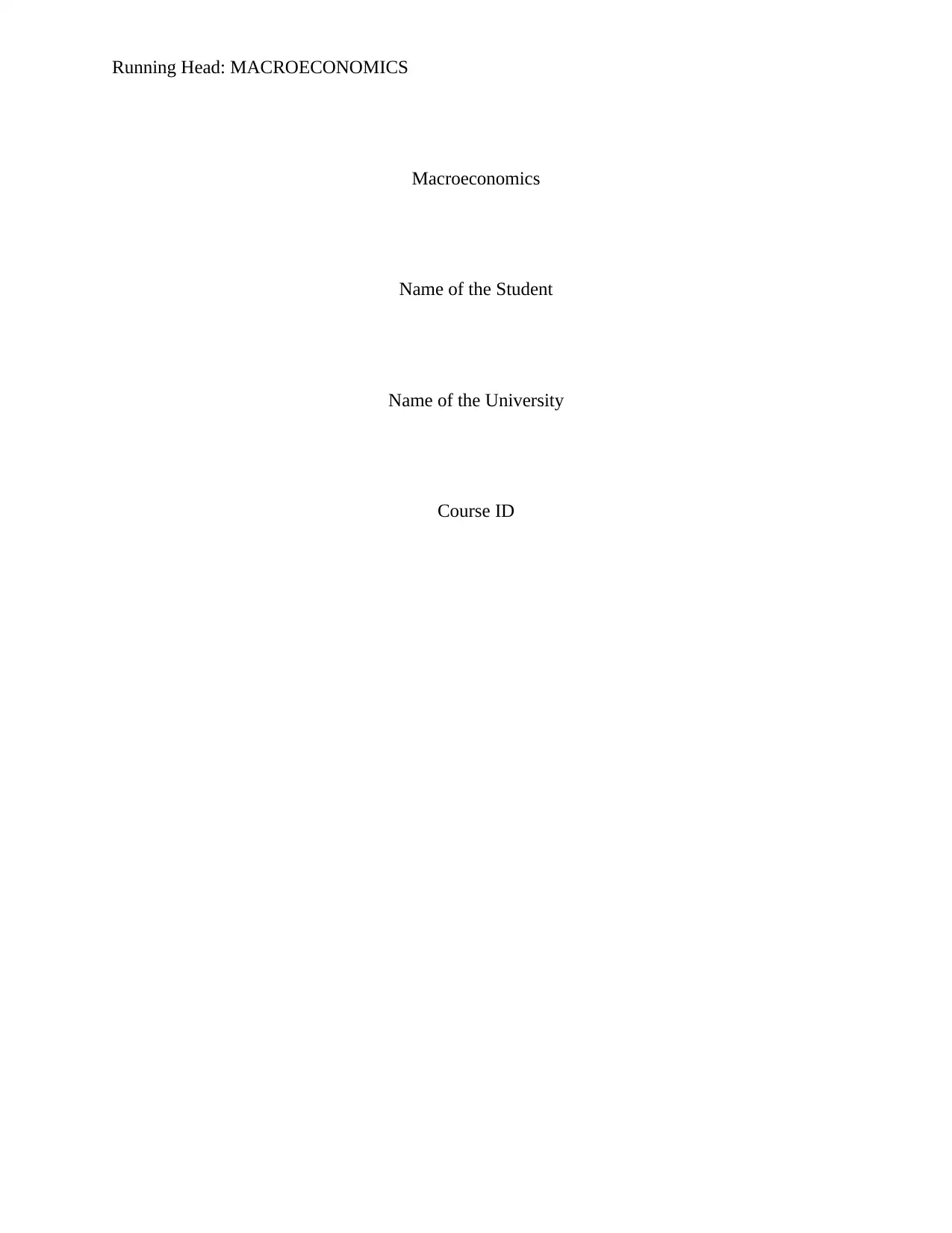
Running Head: MACROECONOMICS
Macroeconomics
Name of the Student
Name of the University
Course ID
Macroeconomics
Name of the Student
Name of the University
Course ID
Paraphrase This Document
Need a fresh take? Get an instant paraphrase of this document with our AI Paraphraser
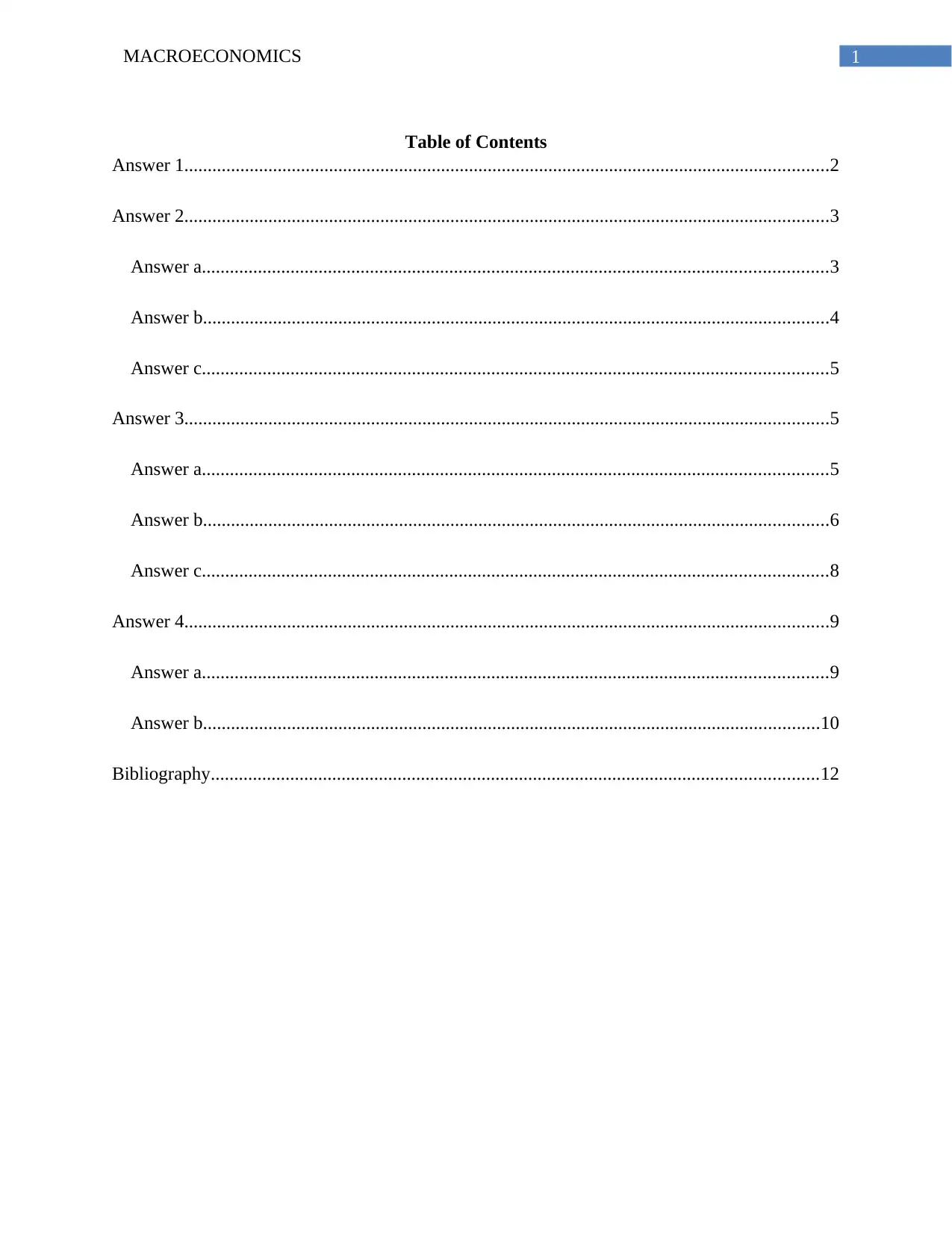
1MACROECONOMICS
Table of Contents
Answer 1..........................................................................................................................................2
Answer 2..........................................................................................................................................3
Answer a......................................................................................................................................3
Answer b......................................................................................................................................4
Answer c......................................................................................................................................5
Answer 3..........................................................................................................................................5
Answer a......................................................................................................................................5
Answer b......................................................................................................................................6
Answer c......................................................................................................................................8
Answer 4..........................................................................................................................................9
Answer a......................................................................................................................................9
Answer b....................................................................................................................................10
Bibliography..................................................................................................................................12
Table of Contents
Answer 1..........................................................................................................................................2
Answer 2..........................................................................................................................................3
Answer a......................................................................................................................................3
Answer b......................................................................................................................................4
Answer c......................................................................................................................................5
Answer 3..........................................................................................................................................5
Answer a......................................................................................................................................5
Answer b......................................................................................................................................6
Answer c......................................................................................................................................8
Answer 4..........................................................................................................................................9
Answer a......................................................................................................................................9
Answer b....................................................................................................................................10
Bibliography..................................................................................................................................12
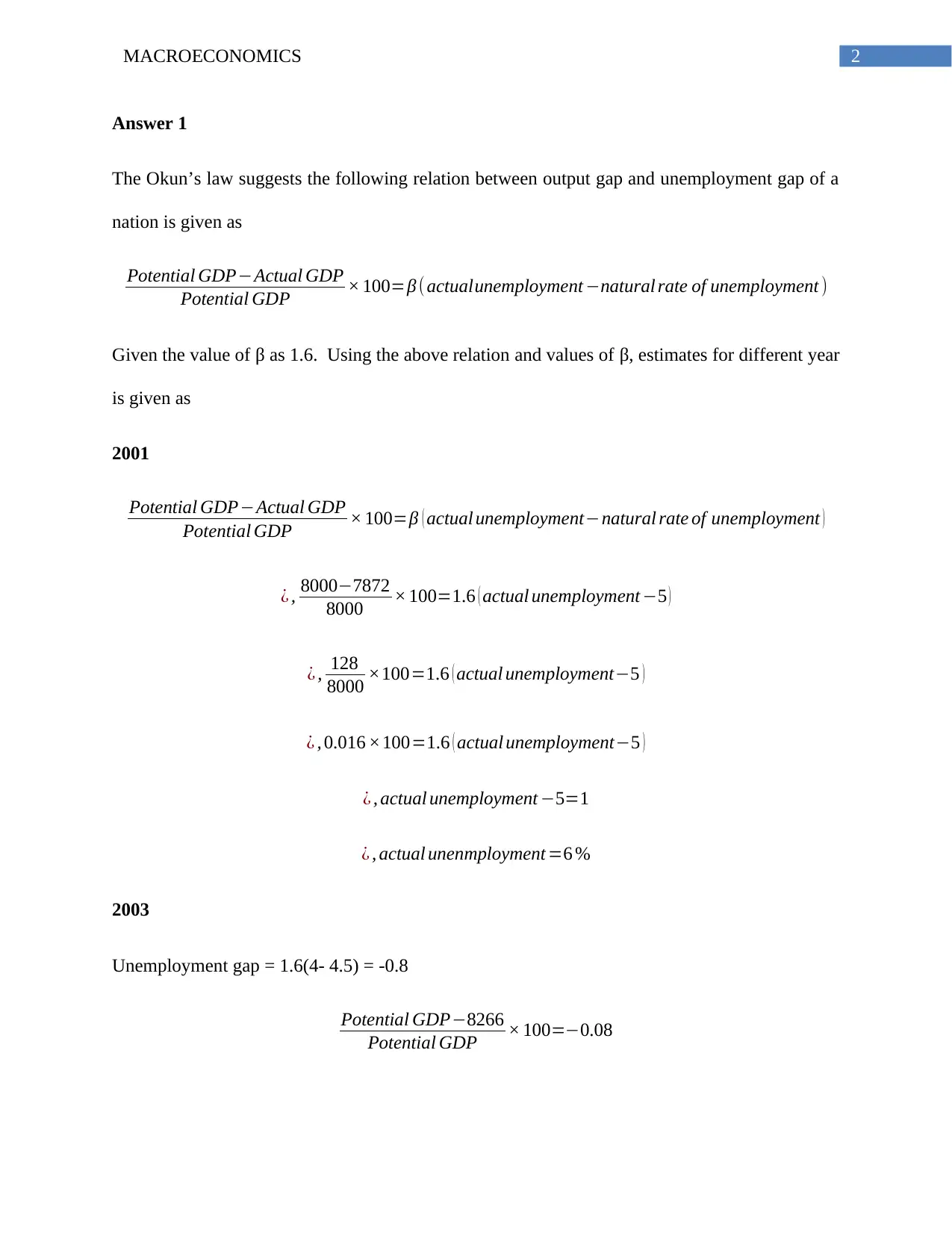
2MACROECONOMICS
Answer 1
The Okun’s law suggests the following relation between output gap and unemployment gap of a
nation is given as
Potential GDP−Actual GDP
Potential GDP × 100=β ( actualunemployment −natural rate of unemployment )
Given the value of β as 1.6. Using the above relation and values of β, estimates for different year
is given as
2001
Potential GDP−Actual GDP
Potential GDP × 100=β ( actual unemployment−natural rate of unemployment )
¿ , 8000−7872
8000 × 100=1.6 ( actual unemployment −5 )
¿ , 128
8000 ×100=1.6 ( actual unemployment−5 )
¿ , 0.016 ×100=1.6 ( actual unemployment−5 )
¿ , actual unemployment −5=1
¿ , actual unenmployment =6 %
2003
Unemployment gap = 1.6(4- 4.5) = -0.8
Potential GDP−8266
Potential GDP × 100=−0.08
Answer 1
The Okun’s law suggests the following relation between output gap and unemployment gap of a
nation is given as
Potential GDP−Actual GDP
Potential GDP × 100=β ( actualunemployment −natural rate of unemployment )
Given the value of β as 1.6. Using the above relation and values of β, estimates for different year
is given as
2001
Potential GDP−Actual GDP
Potential GDP × 100=β ( actual unemployment−natural rate of unemployment )
¿ , 8000−7872
8000 × 100=1.6 ( actual unemployment −5 )
¿ , 128
8000 ×100=1.6 ( actual unemployment−5 )
¿ , 0.016 ×100=1.6 ( actual unemployment−5 )
¿ , actual unemployment −5=1
¿ , actual unenmployment =6 %
2003
Unemployment gap = 1.6(4- 4.5) = -0.8
Potential GDP−8266
Potential GDP × 100=−0.08
⊘ This is a preview!⊘
Do you want full access?
Subscribe today to unlock all pages.

Trusted by 1+ million students worldwide
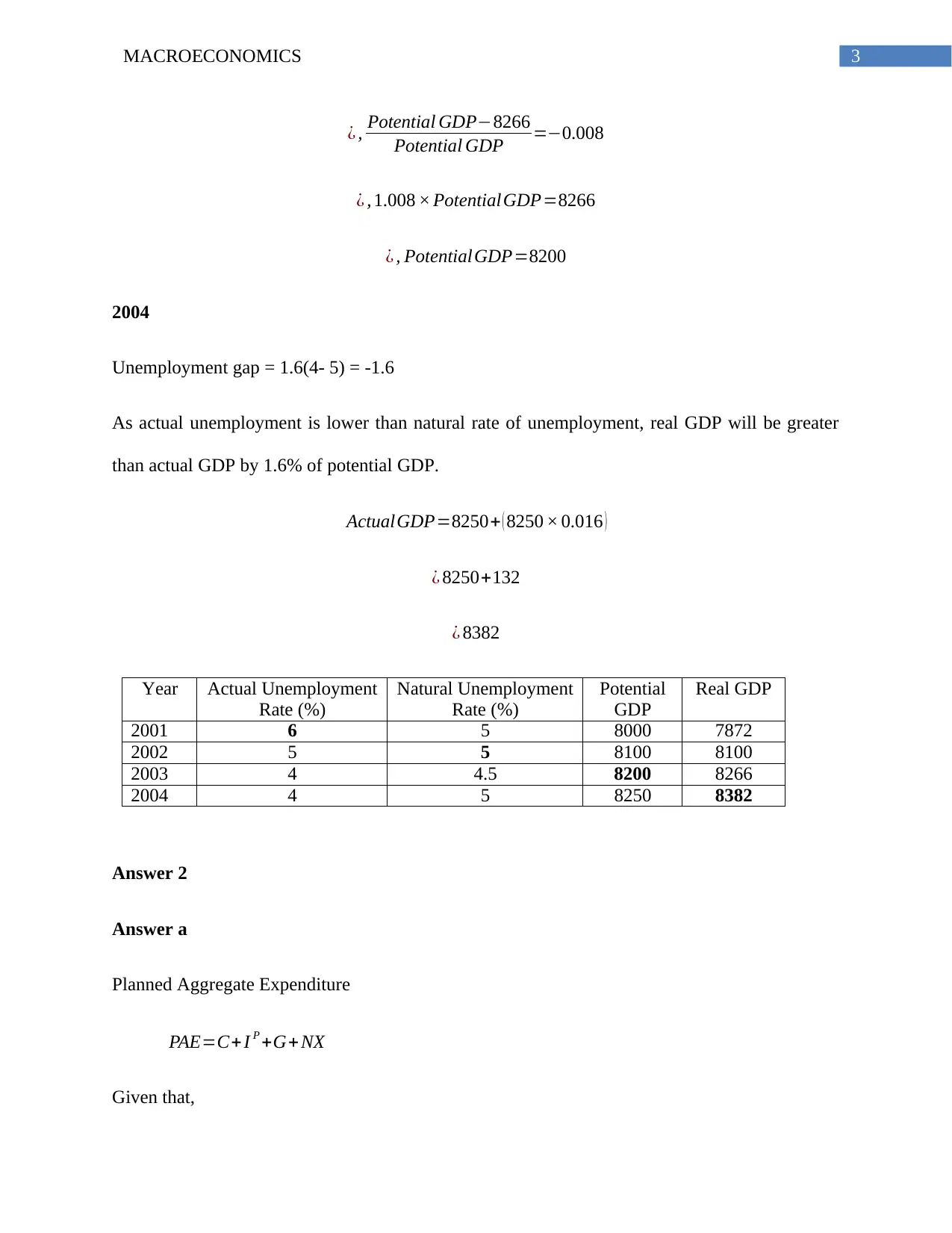
3MACROECONOMICS
¿ , Potential GDP−8266
Potential GDP =−0.008
¿ , 1.008 × PotentialGDP=8266
¿ , PotentialGDP=8200
2004
Unemployment gap = 1.6(4- 5) = -1.6
As actual unemployment is lower than natural rate of unemployment, real GDP will be greater
than actual GDP by 1.6% of potential GDP.
ActualGDP=8250+ ( 8250 × 0.016 )
¿ 8250+132
¿ 8382
Year Actual Unemployment
Rate (%)
Natural Unemployment
Rate (%)
Potential
GDP
Real GDP
2001 6 5 8000 7872
2002 5 5 8100 8100
2003 4 4.5 8200 8266
2004 4 5 8250 8382
Answer 2
Answer a
Planned Aggregate Expenditure
PAE=C+ I P +G+ NX
Given that,
¿ , Potential GDP−8266
Potential GDP =−0.008
¿ , 1.008 × PotentialGDP=8266
¿ , PotentialGDP=8200
2004
Unemployment gap = 1.6(4- 5) = -1.6
As actual unemployment is lower than natural rate of unemployment, real GDP will be greater
than actual GDP by 1.6% of potential GDP.
ActualGDP=8250+ ( 8250 × 0.016 )
¿ 8250+132
¿ 8382
Year Actual Unemployment
Rate (%)
Natural Unemployment
Rate (%)
Potential
GDP
Real GDP
2001 6 5 8000 7872
2002 5 5 8100 8100
2003 4 4.5 8200 8266
2004 4 5 8250 8382
Answer 2
Answer a
Planned Aggregate Expenditure
PAE=C+ I P +G+ NX
Given that,
Paraphrase This Document
Need a fresh take? Get an instant paraphrase of this document with our AI Paraphraser
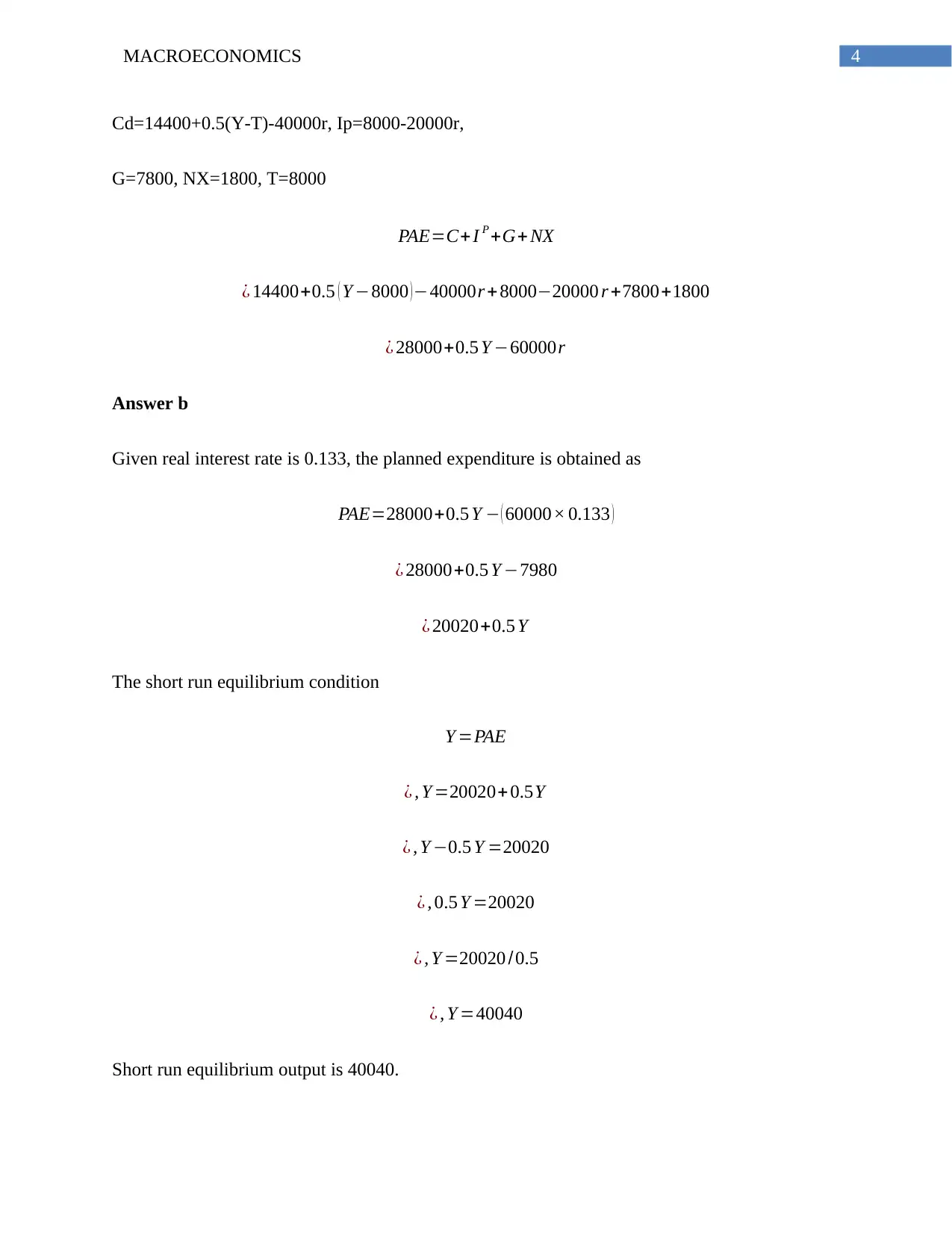
4MACROECONOMICS
Cd=14400+0.5(Y-T)-40000r, Ip=8000-20000r,
G=7800, NX=1800, T=8000
PAE=C+I P +G+ NX
¿ 14400+0.5 ( Y −8000 )−40000r + 8000−20000 r +7800+1800
¿ 28000+0.5 Y −60000r
Answer b
Given real interest rate is 0.133, the planned expenditure is obtained as
PAE=28000+0.5 Y − ( 60000× 0.133 )
¿ 28000+0.5 Y −7980
¿ 20020+0.5 Y
The short run equilibrium condition
Y =PAE
¿ , Y =20020+ 0.5Y
¿ , Y −0.5 Y =20020
¿ , 0.5 Y =20020
¿ , Y =20020 / 0.5
¿ , Y =40040
Short run equilibrium output is 40040.
Cd=14400+0.5(Y-T)-40000r, Ip=8000-20000r,
G=7800, NX=1800, T=8000
PAE=C+I P +G+ NX
¿ 14400+0.5 ( Y −8000 )−40000r + 8000−20000 r +7800+1800
¿ 28000+0.5 Y −60000r
Answer b
Given real interest rate is 0.133, the planned expenditure is obtained as
PAE=28000+0.5 Y − ( 60000× 0.133 )
¿ 28000+0.5 Y −7980
¿ 20020+0.5 Y
The short run equilibrium condition
Y =PAE
¿ , Y =20020+ 0.5Y
¿ , Y −0.5 Y =20020
¿ , 0.5 Y =20020
¿ , Y =20020 / 0.5
¿ , Y =40040
Short run equilibrium output is 40040.
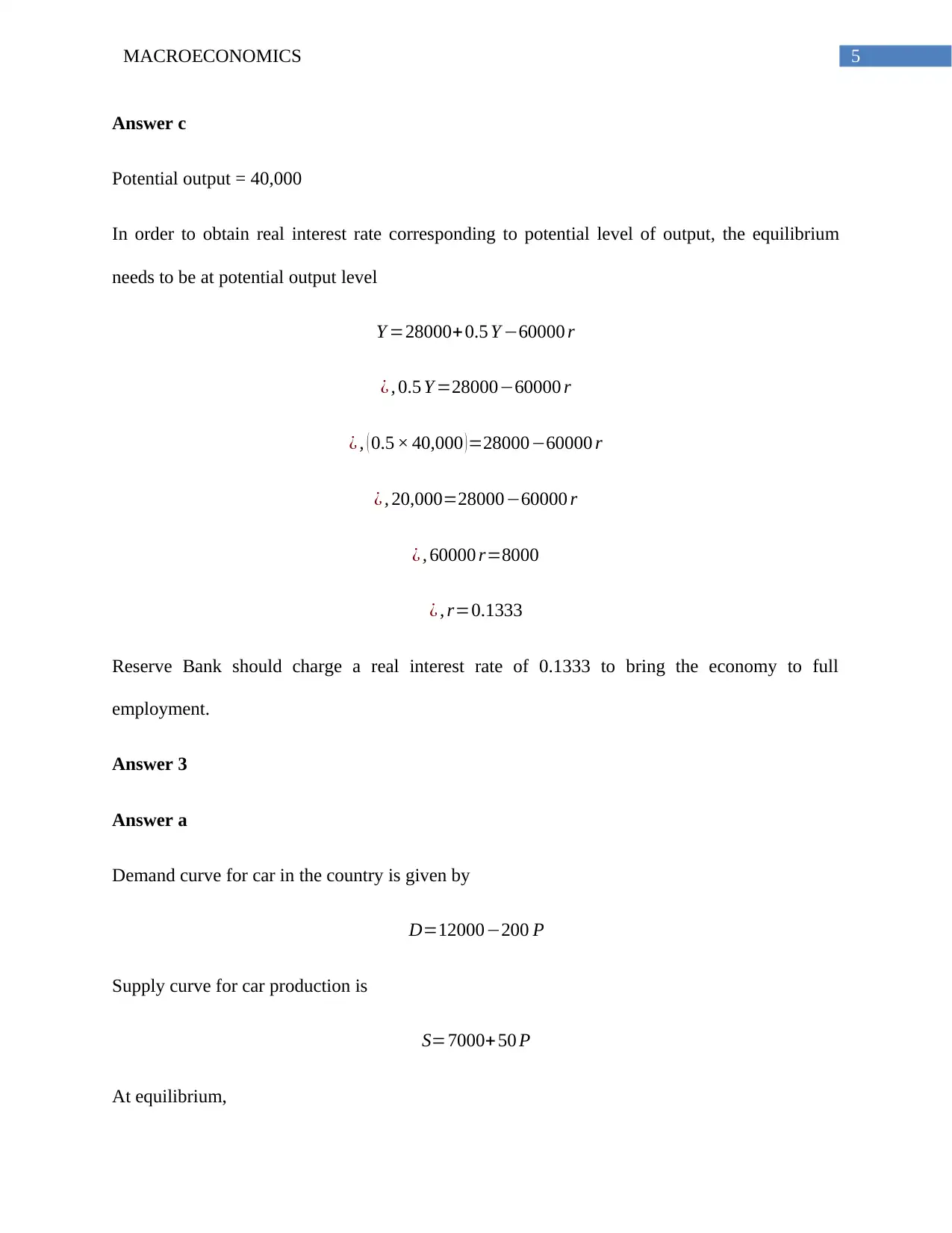
5MACROECONOMICS
Answer c
Potential output = 40,000
In order to obtain real interest rate corresponding to potential level of output, the equilibrium
needs to be at potential output level
Y =28000+ 0.5 Y −60000 r
¿ , 0.5 Y =28000−60000 r
¿ , ( 0.5 × 40,000 )=28000−60000 r
¿ , 20,000=28000−60000 r
¿ , 60000 r=8000
¿ , r=0.1333
Reserve Bank should charge a real interest rate of 0.1333 to bring the economy to full
employment.
Answer 3
Answer a
Demand curve for car in the country is given by
D=12000−200 P
Supply curve for car production is
S=7000+ 50 P
At equilibrium,
Answer c
Potential output = 40,000
In order to obtain real interest rate corresponding to potential level of output, the equilibrium
needs to be at potential output level
Y =28000+ 0.5 Y −60000 r
¿ , 0.5 Y =28000−60000 r
¿ , ( 0.5 × 40,000 )=28000−60000 r
¿ , 20,000=28000−60000 r
¿ , 60000 r=8000
¿ , r=0.1333
Reserve Bank should charge a real interest rate of 0.1333 to bring the economy to full
employment.
Answer 3
Answer a
Demand curve for car in the country is given by
D=12000−200 P
Supply curve for car production is
S=7000+ 50 P
At equilibrium,
⊘ This is a preview!⊘
Do you want full access?
Subscribe today to unlock all pages.

Trusted by 1+ million students worldwide
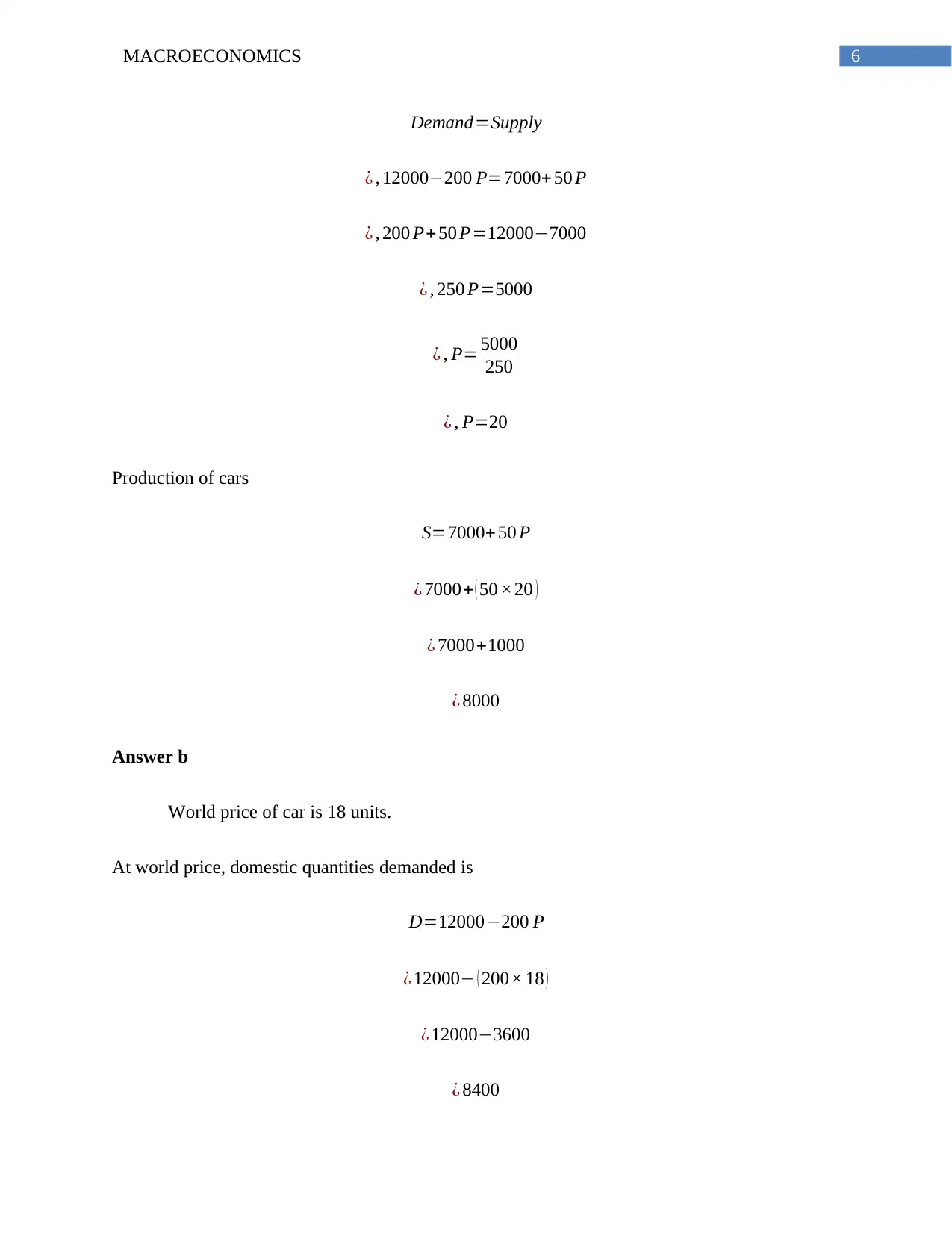
6MACROECONOMICS
Demand=Supply
¿ , 12000−200 P=7000+ 50 P
¿ , 200 P+50 P=12000−7000
¿ , 250 P=5000
¿ , P= 5000
250
¿ , P=20
Production of cars
S=7000+ 50 P
¿ 7000+ ( 50 ×20 )
¿ 7000+1000
¿ 8000
Answer b
World price of car is 18 units.
At world price, domestic quantities demanded is
D=12000−200 P
¿ 12000− ( 200× 18 )
¿ 12000−3600
¿ 8400
Demand=Supply
¿ , 12000−200 P=7000+ 50 P
¿ , 200 P+50 P=12000−7000
¿ , 250 P=5000
¿ , P= 5000
250
¿ , P=20
Production of cars
S=7000+ 50 P
¿ 7000+ ( 50 ×20 )
¿ 7000+1000
¿ 8000
Answer b
World price of car is 18 units.
At world price, domestic quantities demanded is
D=12000−200 P
¿ 12000− ( 200× 18 )
¿ 12000−3600
¿ 8400
Paraphrase This Document
Need a fresh take? Get an instant paraphrase of this document with our AI Paraphraser
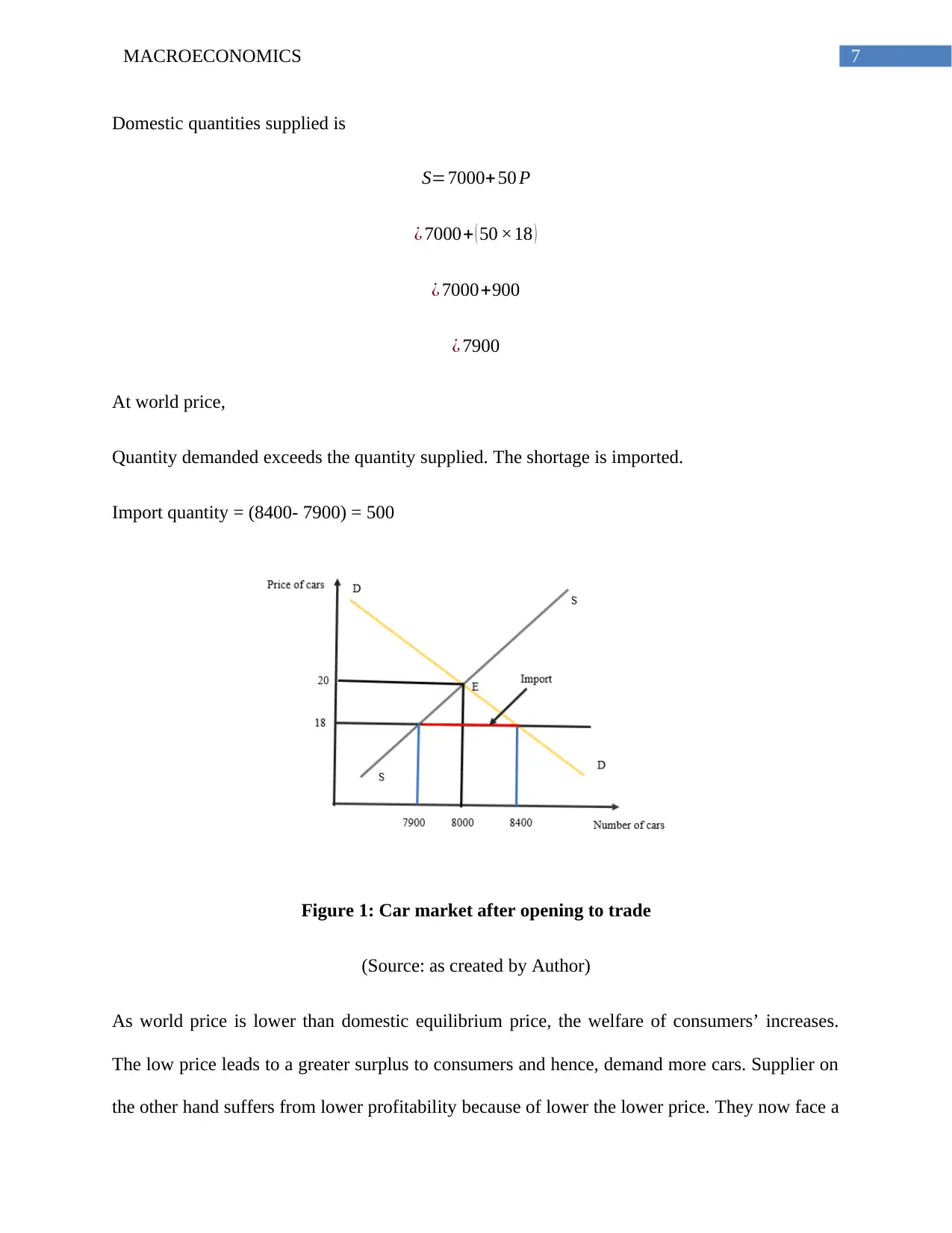
7MACROECONOMICS
Domestic quantities supplied is
S=7000+ 50 P
¿ 7000+ ( 50 ×18 )
¿ 7000+900
¿ 7900
At world price,
Quantity demanded exceeds the quantity supplied. The shortage is imported.
Import quantity = (8400- 7900) = 500
Figure 1: Car market after opening to trade
(Source: as created by Author)
As world price is lower than domestic equilibrium price, the welfare of consumers’ increases.
The low price leads to a greater surplus to consumers and hence, demand more cars. Supplier on
the other hand suffers from lower profitability because of lower the lower price. They now face a
Domestic quantities supplied is
S=7000+ 50 P
¿ 7000+ ( 50 ×18 )
¿ 7000+900
¿ 7900
At world price,
Quantity demanded exceeds the quantity supplied. The shortage is imported.
Import quantity = (8400- 7900) = 500
Figure 1: Car market after opening to trade
(Source: as created by Author)
As world price is lower than domestic equilibrium price, the welfare of consumers’ increases.
The low price leads to a greater surplus to consumers and hence, demand more cars. Supplier on
the other hand suffers from lower profitability because of lower the lower price. They now face a
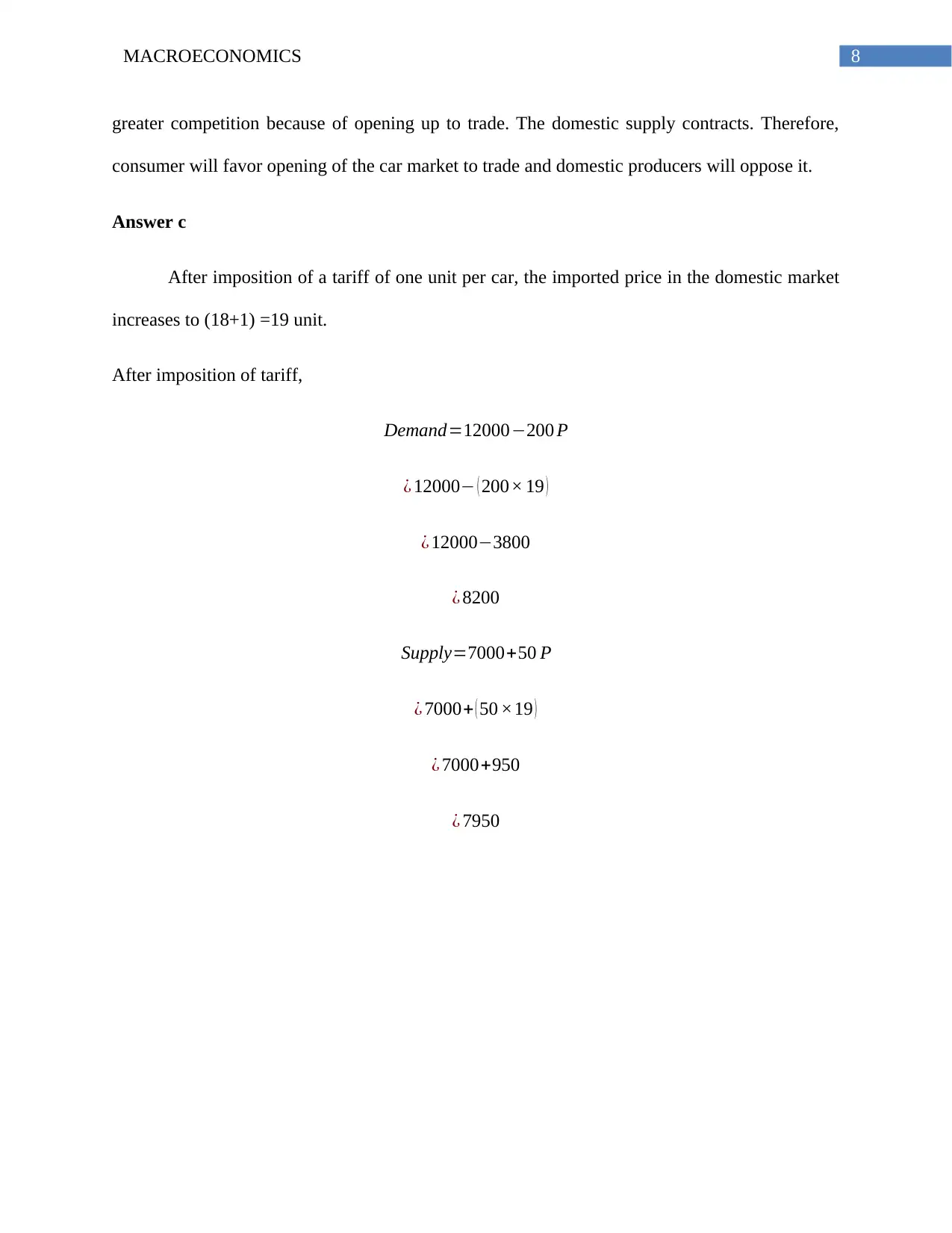
8MACROECONOMICS
greater competition because of opening up to trade. The domestic supply contracts. Therefore,
consumer will favor opening of the car market to trade and domestic producers will oppose it.
Answer c
After imposition of a tariff of one unit per car, the imported price in the domestic market
increases to (18+1) =19 unit.
After imposition of tariff,
Demand=12000−200 P
¿ 12000− ( 200× 19 )
¿ 12000−3800
¿ 8200
Supply=7000+50 P
¿ 7000+ ( 50 ×19 )
¿ 7000+950
¿ 7950
greater competition because of opening up to trade. The domestic supply contracts. Therefore,
consumer will favor opening of the car market to trade and domestic producers will oppose it.
Answer c
After imposition of a tariff of one unit per car, the imported price in the domestic market
increases to (18+1) =19 unit.
After imposition of tariff,
Demand=12000−200 P
¿ 12000− ( 200× 19 )
¿ 12000−3800
¿ 8200
Supply=7000+50 P
¿ 7000+ ( 50 ×19 )
¿ 7000+950
¿ 7950
⊘ This is a preview!⊘
Do you want full access?
Subscribe today to unlock all pages.

Trusted by 1+ million students worldwide
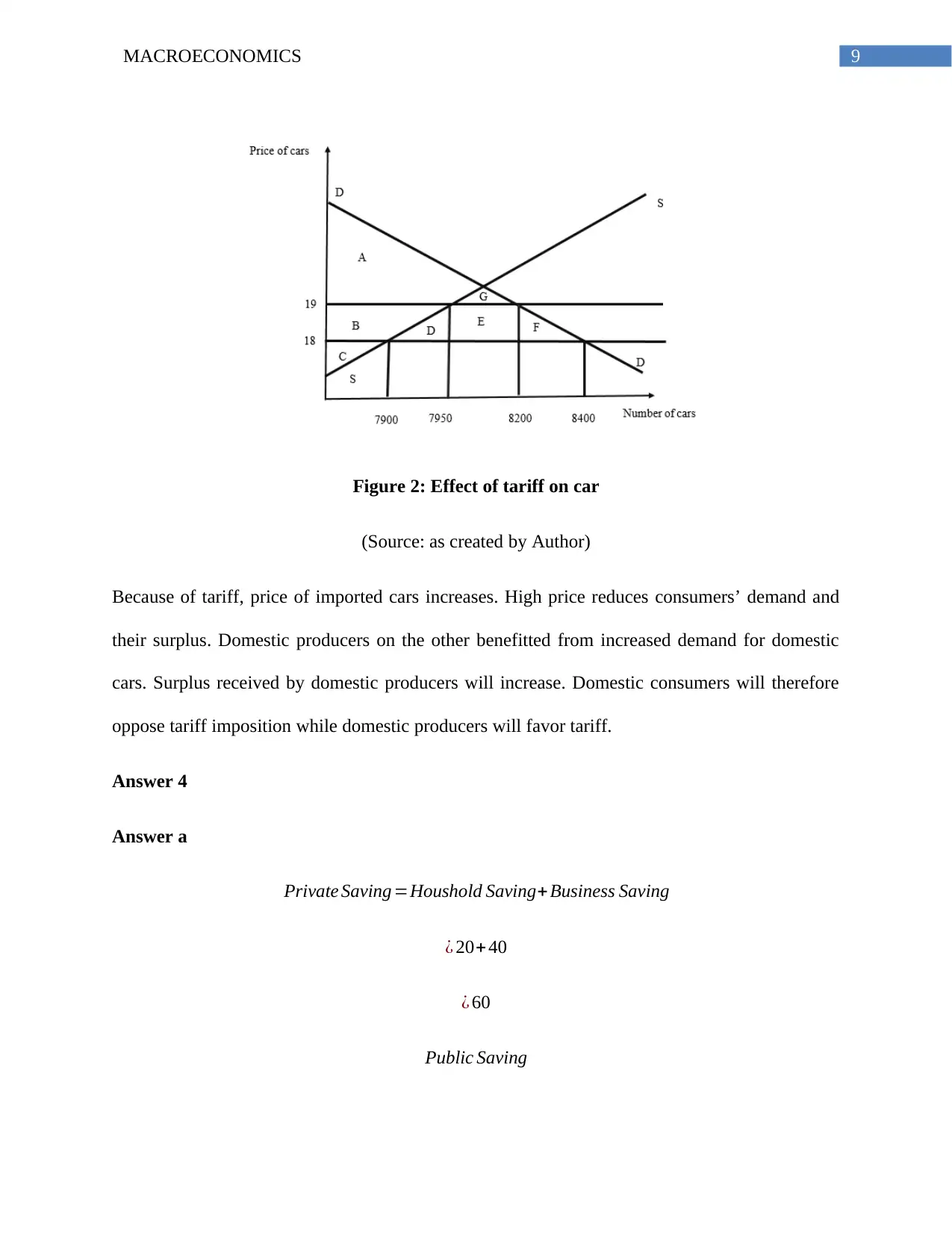
9MACROECONOMICS
Figure 2: Effect of tariff on car
(Source: as created by Author)
Because of tariff, price of imported cars increases. High price reduces consumers’ demand and
their surplus. Domestic producers on the other benefitted from increased demand for domestic
cars. Surplus received by domestic producers will increase. Domestic consumers will therefore
oppose tariff imposition while domestic producers will favor tariff.
Answer 4
Answer a
Private Saving =Houshold Saving+ Business Saving
¿ 20+ 40
¿ 60
Public Saving
Figure 2: Effect of tariff on car
(Source: as created by Author)
Because of tariff, price of imported cars increases. High price reduces consumers’ demand and
their surplus. Domestic producers on the other benefitted from increased demand for domestic
cars. Surplus received by domestic producers will increase. Domestic consumers will therefore
oppose tariff imposition while domestic producers will favor tariff.
Answer 4
Answer a
Private Saving =Houshold Saving+ Business Saving
¿ 20+ 40
¿ 60
Public Saving
Paraphrase This Document
Need a fresh take? Get an instant paraphrase of this document with our AI Paraphraser
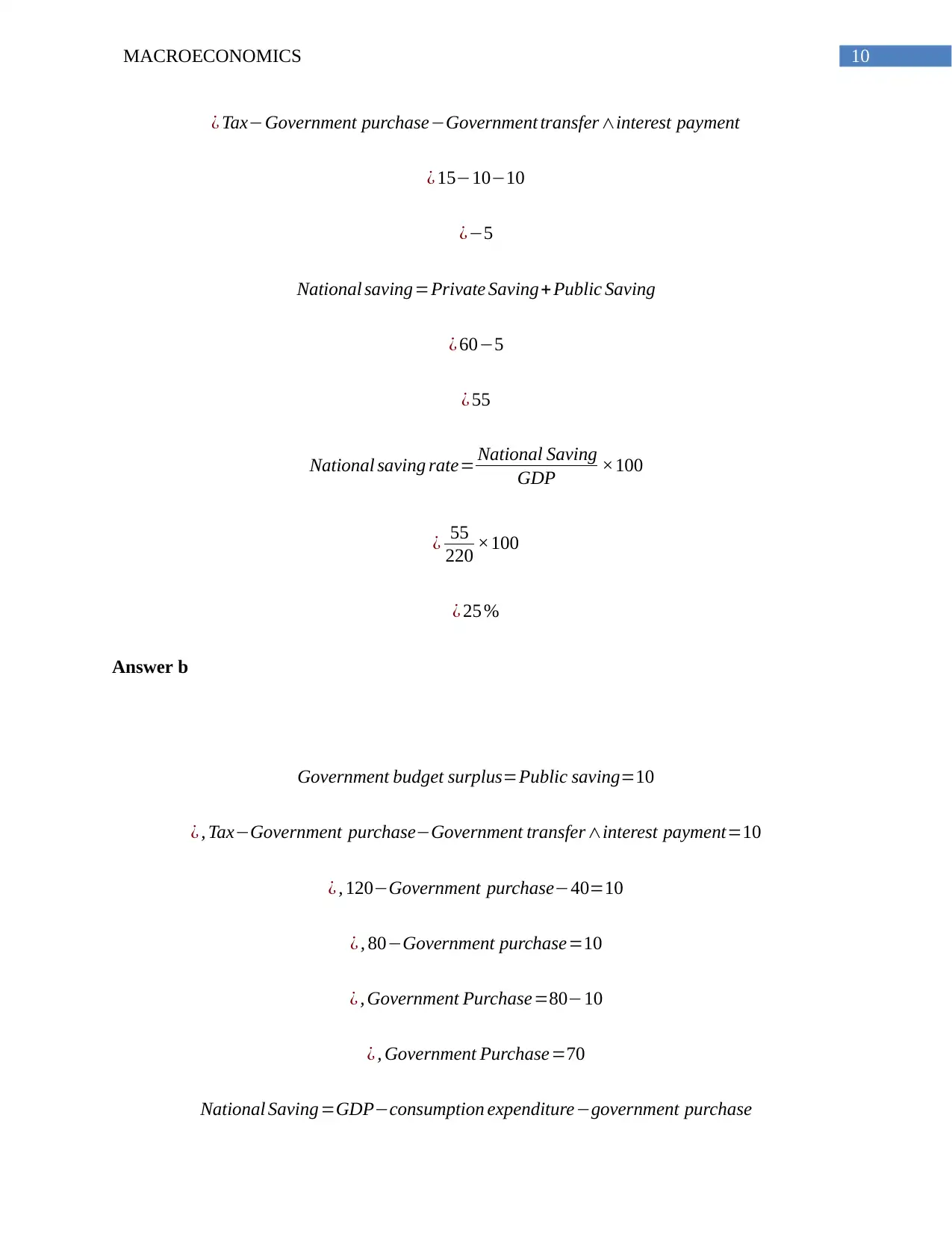
10MACROECONOMICS
¿ Tax−Government purchase−Government transfer∧interest payment
¿ 15−10−10
¿−5
National saving=Private Saving+Public Saving
¿ 60−5
¿ 55
National saving rate= National Saving
GDP ×100
¿ 55
220 ×100
¿ 25 %
Answer b
Government budget surplus=Public saving=10
¿ , Tax−Government purchase−Government transfer∧interest payment=10
¿ , 120−Government purchase−40=10
¿ , 80−Government purchase=10
¿ , Government Purchase=80−10
¿ , Government Purchase=70
National Saving =GDP−consumption expenditure−government purchase
¿ Tax−Government purchase−Government transfer∧interest payment
¿ 15−10−10
¿−5
National saving=Private Saving+Public Saving
¿ 60−5
¿ 55
National saving rate= National Saving
GDP ×100
¿ 55
220 ×100
¿ 25 %
Answer b
Government budget surplus=Public saving=10
¿ , Tax−Government purchase−Government transfer∧interest payment=10
¿ , 120−Government purchase−40=10
¿ , 80−Government purchase=10
¿ , Government Purchase=80−10
¿ , Government Purchase=70
National Saving =GDP−consumption expenditure−government purchase
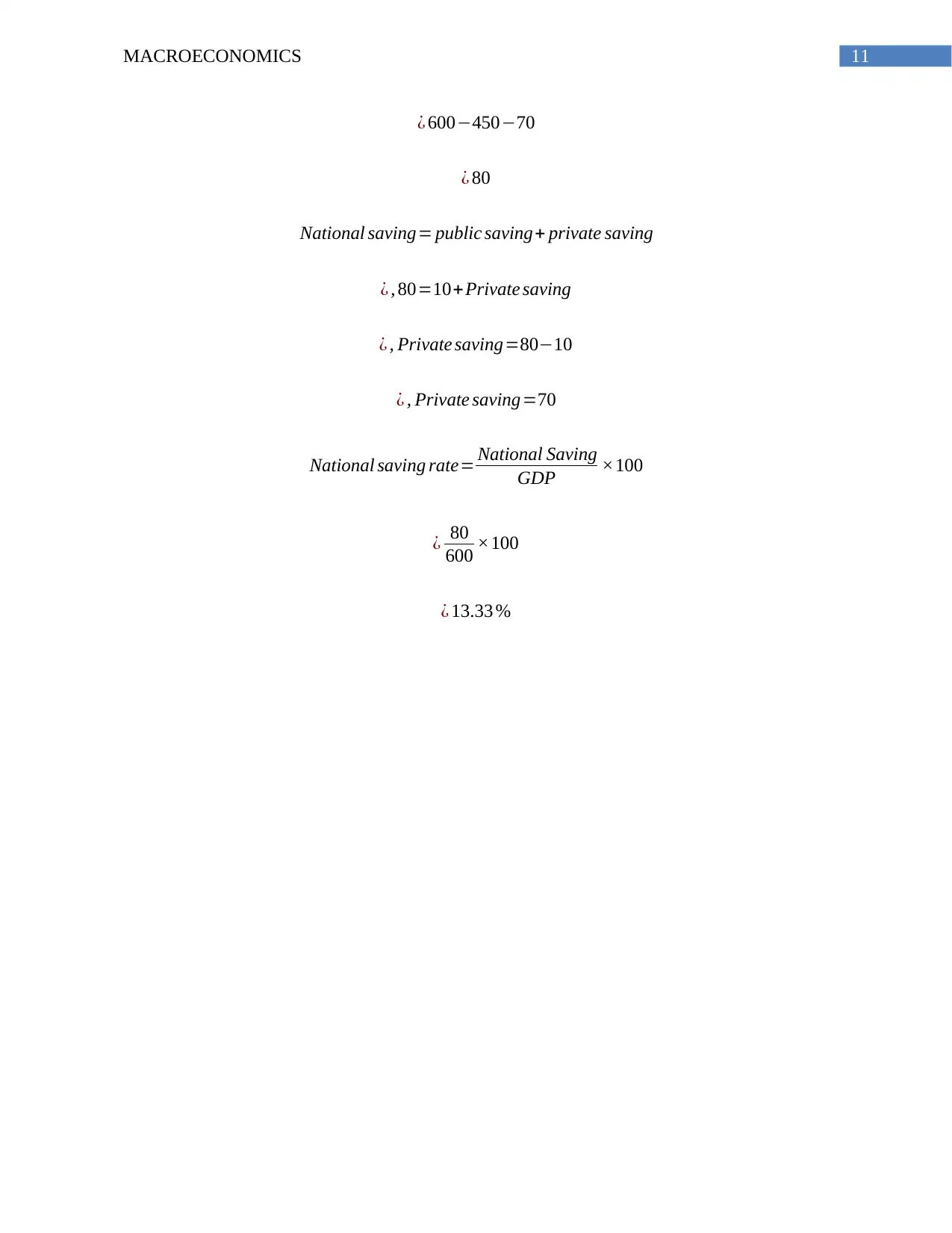
11MACROECONOMICS
¿ 600−450−70
¿ 80
National saving= public saving+ private saving
¿ , 80=10+Private saving
¿ , Private saving=80−10
¿ , Private saving=70
National saving rate= National Saving
GDP ×100
¿ 80
600 ×100
¿ 13.33 %
¿ 600−450−70
¿ 80
National saving= public saving+ private saving
¿ , 80=10+Private saving
¿ , Private saving=80−10
¿ , Private saving=70
National saving rate= National Saving
GDP ×100
¿ 80
600 ×100
¿ 13.33 %
⊘ This is a preview!⊘
Do you want full access?
Subscribe today to unlock all pages.

Trusted by 1+ million students worldwide
1 out of 13
Related Documents
Your All-in-One AI-Powered Toolkit for Academic Success.
+13062052269
info@desklib.com
Available 24*7 on WhatsApp / Email
![[object Object]](/_next/static/media/star-bottom.7253800d.svg)
Unlock your academic potential
Copyright © 2020–2025 A2Z Services. All Rights Reserved. Developed and managed by ZUCOL.





